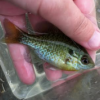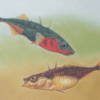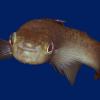While poking around in the San Gabriel in hopes of finding some water scorpions, I discovered that there are baby toebiters (Lethocerus americanus) hiding under the loose rocks. Hence, I now have two baby toebiters, though I suspect I'll only have one soon- they're different sizes. The larger of the two is about half an inch long, the smaller is maybe a quarter of an inch. They'll be going into a 2.5g, but it needs rearranging/cleaning, so they're just sitting in a cup of river water for now.
My main question is, what water do I put them in? We have a water softener, but our outside water (hoses, sprinklers, etc) isn't hooked up to it. I could also use grocery store RO water or spring water, but hose water (after the hose runs long enough so that the water isn't the stuff that's been sitting in the hose all day) would be easiest. I clearly need an answer for this one first. If I don't get an answer within today, I'm gonna use the spring water I have on hand, plus maybe some dechlorinator just in case.
Second question, what would be the best thing to feed them? I have frozen mysis, frozen bloodworms, frozen krilll, and some slightly freezerburned silversides. I plan to stick the food on a toothpick or hold it in tweezers and just wiggle it in their faces until they chomp it- works for dragonfly larvae and carnivorous beetle grubs. And how big should the food be? A bit smaller than the bug?
Third, what's a good temperature? My room gets pretty cold (I have a window unit and keep it cranked up), and I do have a little heater that keeps the tank at about 76F, which feels about the same as the river. Is that a decent temp for them in the summer?
Fourth, about how long will they take to grow to about full size, and how long will they live? Can't seem to find a consistent answer online.
Also, apparently if you ask "Anyone wanna see a cool bug?" in the vicinity of a biker gang, the answer will be a resounding yes. Have just shown two baby toebiters to about 10 bikers. Turns out bikers like cool bugs.










